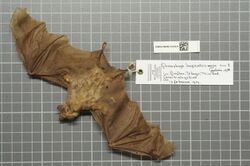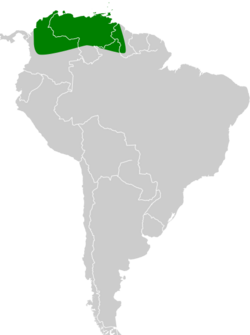Biology:Miller's long-tongued bat
| Miller's long-tongued bat | |
|---|---|

| |
| Scientific classification | |
| Domain: | Eukaryota |
| Kingdom: | Animalia |
| Phylum: | Chordata |
| Class: | Mammalia |
| Order: | Chiroptera |
| Family: | Phyllostomidae |
| Genus: | Glossophaga |
| Species: | G. longirostris
|
| Binomial name | |
| Glossophaga longirostris Miller, 1898
| |

| |
Miller's long-tongued bat (Glossophaga longirostris) is a bat species found in northern Brazil , Venezuela, Colombia, Guyana, Trinidad and Tobago, Grenada, the Netherlands Antilles and the U.S. Virgin Islands.[1][2]
Taxonomy
Miller's long-tongued bat was described as a new species in 1898 by American zoologist Gerrit Smith Miller Jr.. The holotype had been collected in the Sierra Nevada de Santa Marta of Colombia by Wilmot W. Brown Jr..[3] Six or seven subspecies are typically recognized.[4]
Description
Glossophaga species are small, with average forearm lengths ranging from 31–42 mm (1.2–1.7 in). Miller's long-tongued bat has a braincase that is equivalent in length to its snout, whereas other members of the genus have a shorter snout relative to the braincase. Its dental formula is 2.1.2.32.1.3.3 for a total of 34 teeth.[4] Males weigh an average of 13.25 g (0.467 oz), while nonpregnant females weigh 12.81 g (0.452 oz).[5]
Biology
Miller's long-tongued bat is nectarivorous, with cacti blossoms as an important food source.[6][5] Two breeding seasons occur annually: December–April and June–October.[4] The litter size is one pup.[6]
Range and habitat
Miller's long-tongued bat is found in the following countries and territories: Colombia, Venezuela, Trinidad and Tobago, the Netherlands Antilles, Guyana, Brazil, and Ecuador. In the Lesser Antilles its range extends northwards to St. Vincent. They roost in caves, houses, and rock crevices.[4]
References
- ↑ 1.0 1.1 Solari, S. (2018). "Glossophaga longirostris". IUCN Red List of Threatened Species 2018: e.T9275A22108249. doi:10.2305/IUCN.UK.2018-2.RLTS.T9275A22108249.en. https://www.iucnredlist.org/species/9275/22108249. Retrieved 19 November 2021.
- ↑ Simmons, Nancy B. (2005), "Chiroptera", in Wilson, Don E.; Reeder, DeeAnn M., Mammal Species of the World: A Taxonomic and Geographic Reference (3rd ed.), Baltimore: Johns Hopkins University Press, pp. 312–529, ISBN 978-0-8018-8221-0, https://www.departments.bucknell.edu/biology/resources/msw3/browse.asp?id=13801149, retrieved 13 September 2009
- ↑ Miller, G. S. (1898). Descriptions of five new phyllostome bats. Cambridge, MA: Harvard University. pp. 334–337. https://books.google.com/books?id=56MrAAAAYAAJ. Retrieved October 10, 2017.
- ↑ 4.0 4.1 4.2 4.3 Gardner, Alfred. Mammals of South America Volume 1. University of Chicago Press. p. 236-239.
- ↑ 5.0 5.1 Webster, W. D.; Handley, C. O. (1986). "Systematics of Miller's long-tongued bat, Glossophaga longirostris: with descriptions of two new subspecies". Occasional Papers the Museum of Texas Tech University 100. https://www.depts.ttu.edu/nsrl/publications/downloads/OP100.pdf.
- ↑ 6.0 6.1 Petit, Sophie (1997). "The Diet and Reproductive Schedules of Leptonycteris curasoae curasoae and Glossophaga longirostris elongata (Chiroptera: Glossophaginae) on Curaçao". Biotropica 29 (2): 214–223. doi:10.1111/j.1744-7429.1997.tb00026.x. Bibcode: 1997Biotr..29..214P.
Wikidata ☰ Q306873 entry
 |


